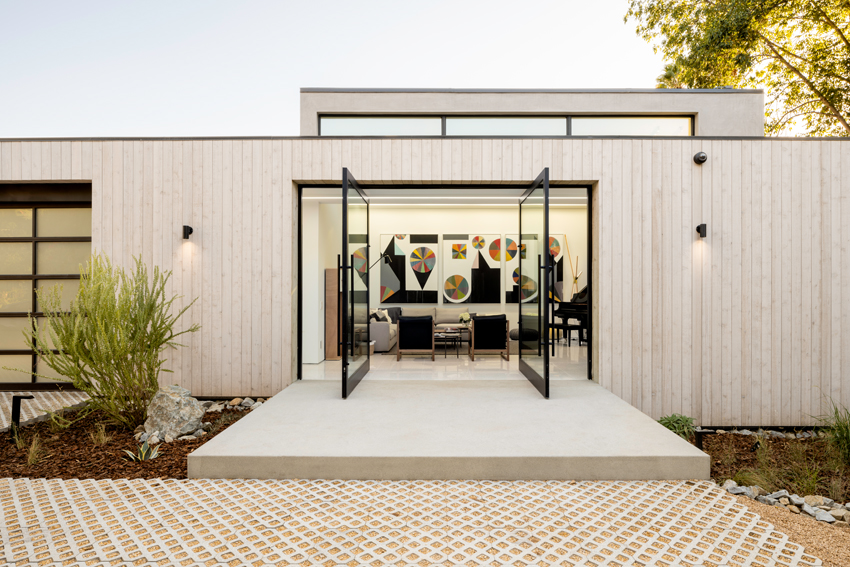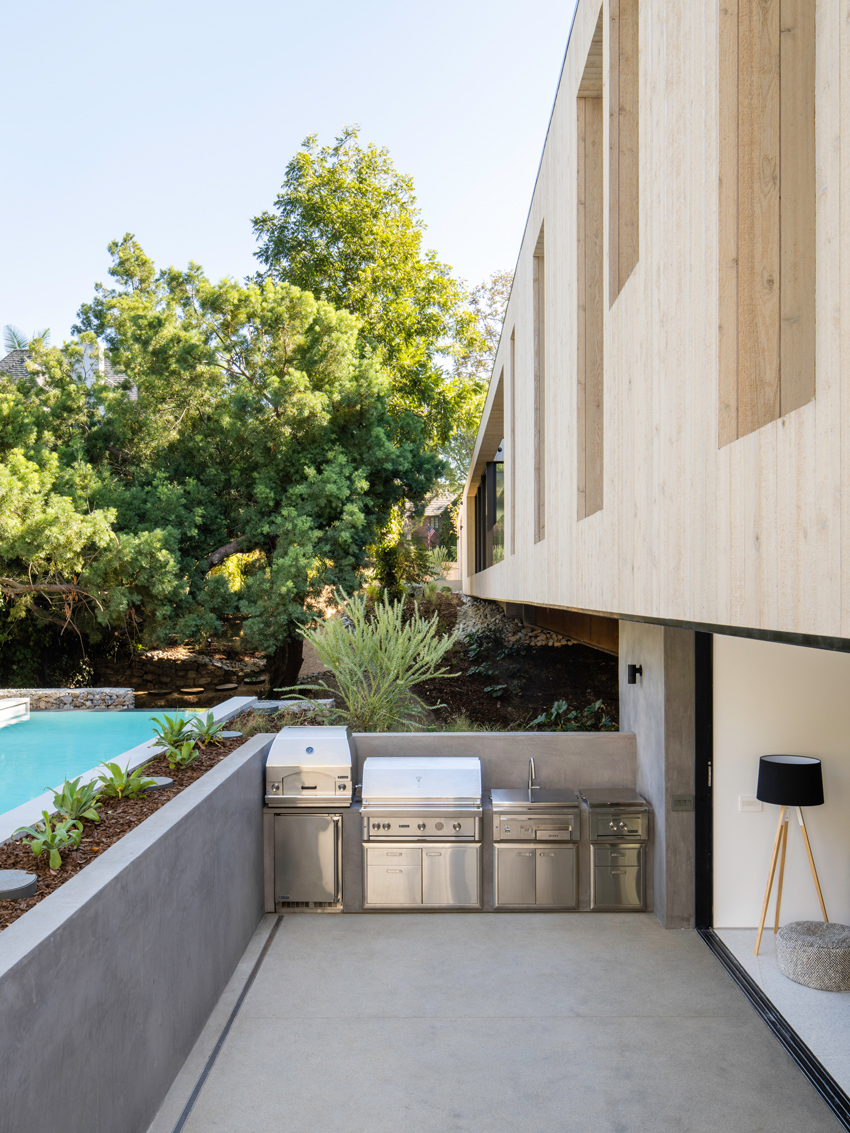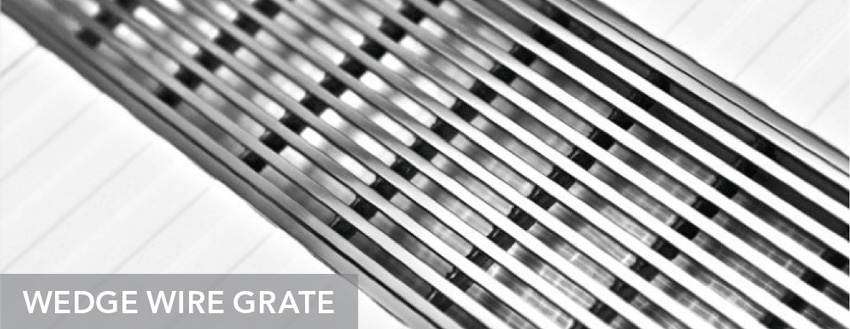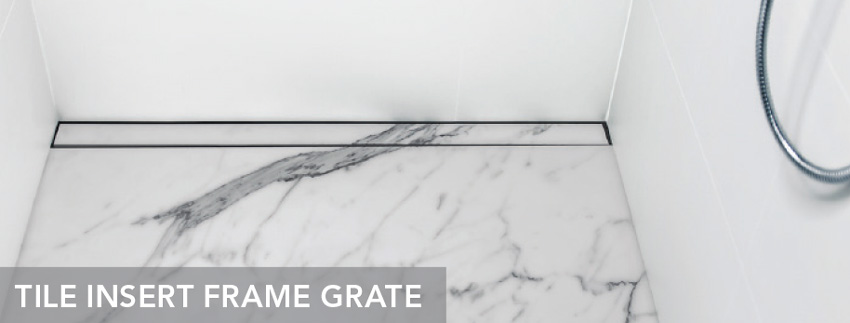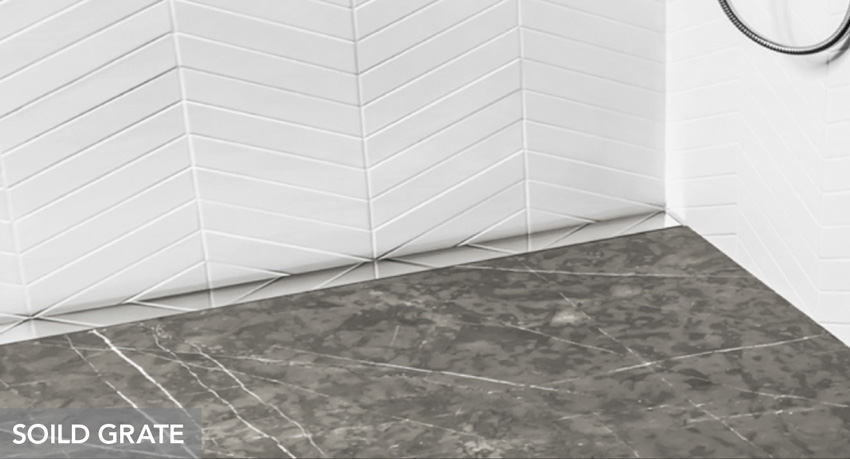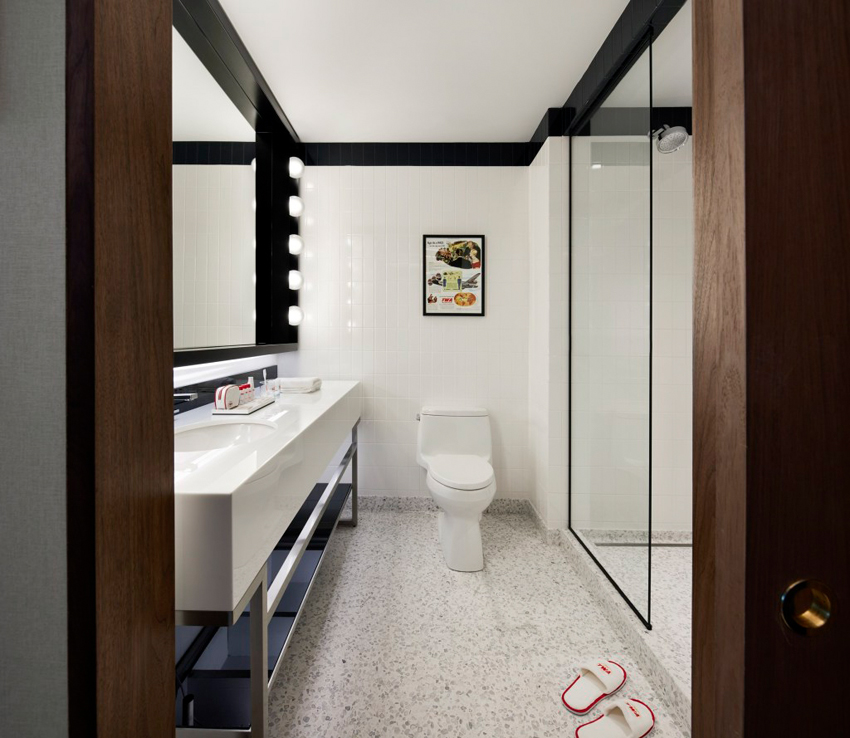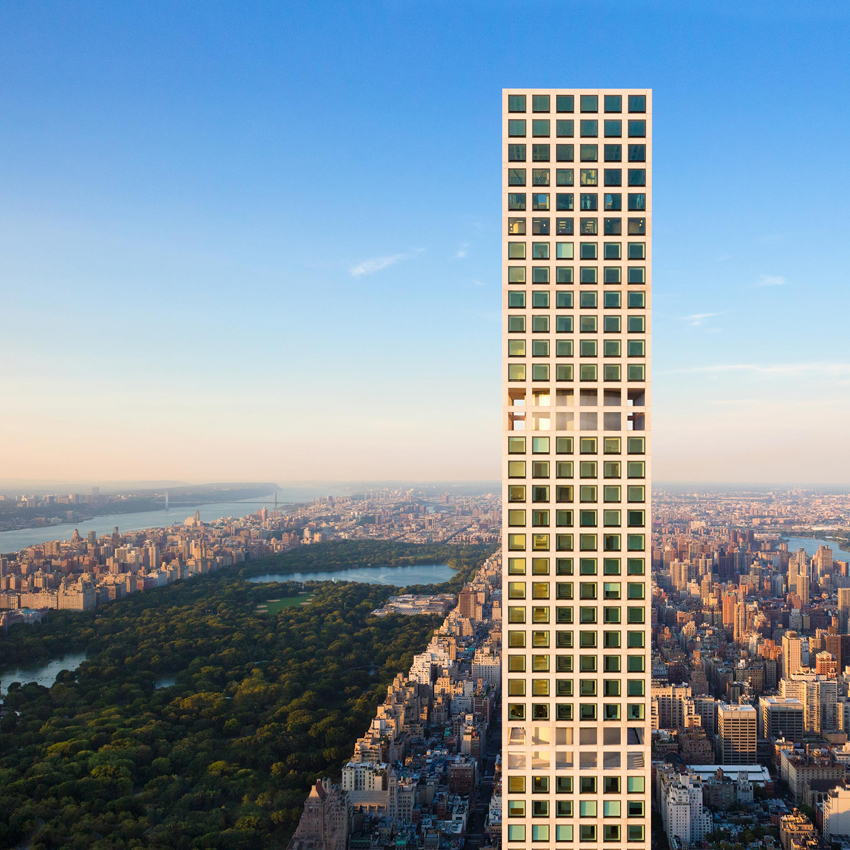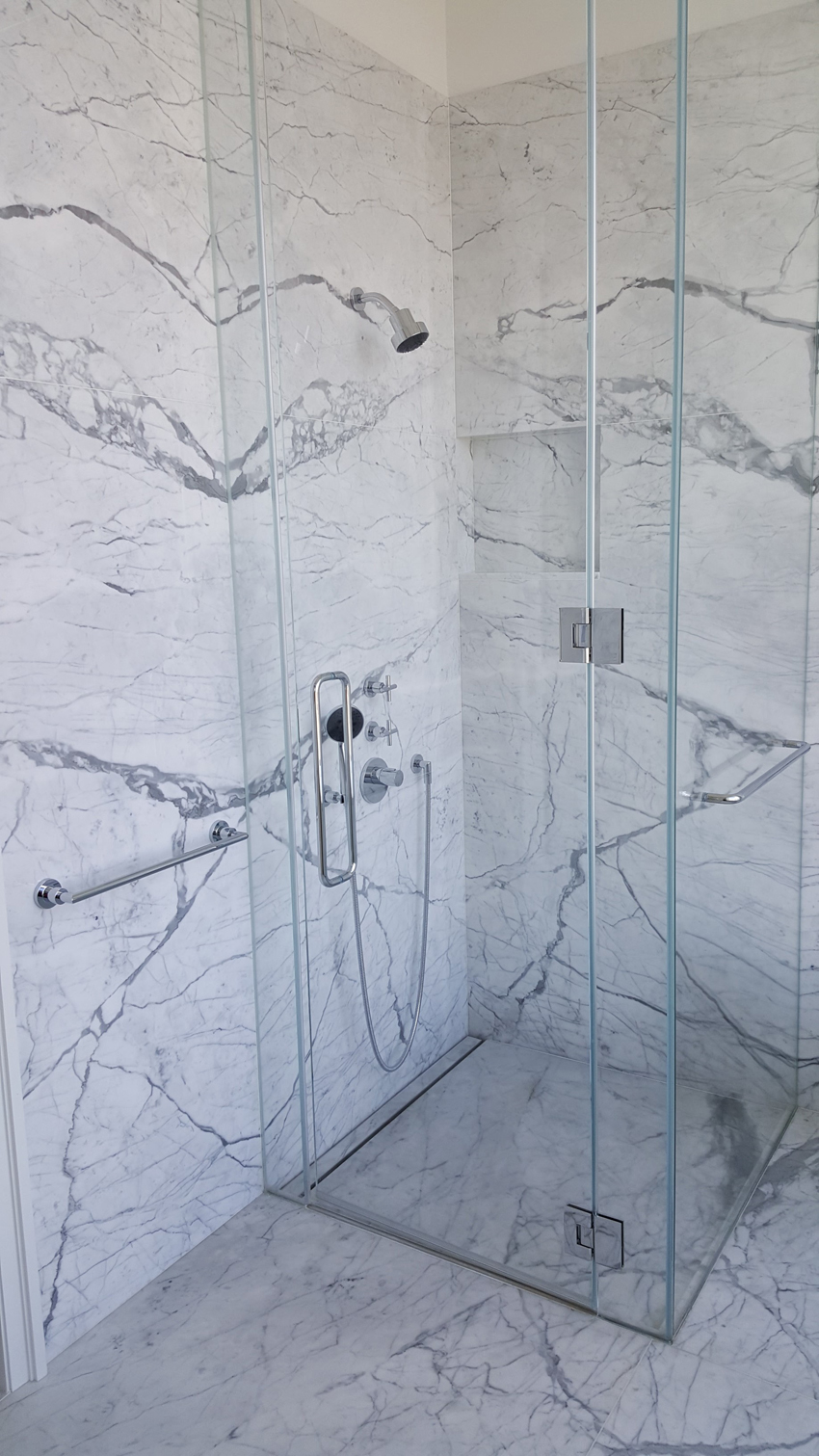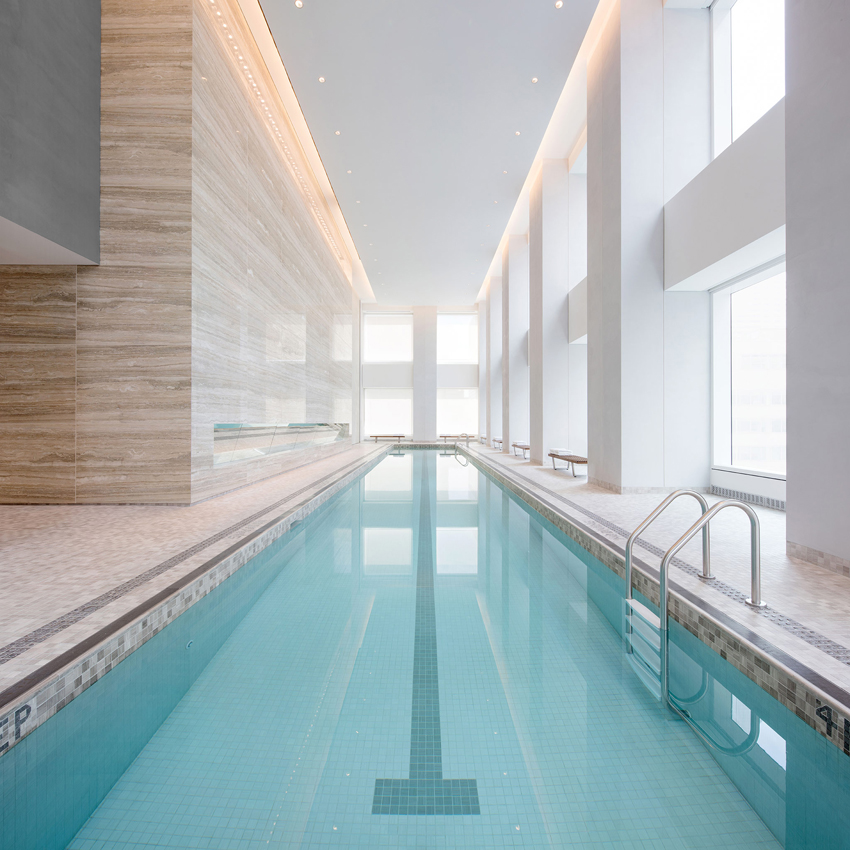This CE Center article is no longer eligible for receiving credits.
Specifying A Linear Drain System Based on Function
Which linear drain system is best for a given project? This is based on whether it is a barrier-free bathroom and which waterproofing technique the installer will be using.
Traditional versus Modern Waterproofing
The difference between traditional and modern waterproofing methods is being able to tile directly on the waterproofing membrane (instead of having a secondary mortar layer), which saves floor height in installation and can be beneficial in designing barrier-free and curbless showers.

The difference between traditional and modern waterproofing methods is being able to tile directly on the waterproofing membrane (instead of having a secondary mortar layer), which saves floor height in installation and can be beneficial in designing barrier-free and curbless showers.
Traditional North American waterproofing methods require multiple levels of installation, skill sets, and limited square footage. The traditional method for installing a tiled shower begins with the installation of a mortar bed that is sloped to the weep holes in the clamping floor drain. A waterproofing membrane, typically referred to as a pan liner, is subsequently placed over this "pre-slope" and clamped into the drain.
Regionally Specific Waterproofing Methods
Pan liners may consist of metals such as lead and copper, or plastics such as polyvinyl chloride (PVC)and chlorinated polyethylene (CPE). In the Northeastern part of the United States, lead or copper pans are still a popular way to waterproof a shower.
In some regions of the country, specifically in Southern California, installers also employ hot mop systems that involve applying layers of asphalt and roofing felt to build up a pan liner. Pan liners are carried up to a height of at least 3 inches above the finished height of the curb and must not be penetrated by any fasteners. Pan liners are not designed to allow for the direct application of ceramic or stone tile.
Membrane and Pan Liner
The most mainstream way to waterproof a shower, and what most showers in the United States utilize, is the vinyl pan liner or rubber liner. This method uses a thick yet flexible membrane to create an envelope on the shower floor and up a small portion of the walls. It is almost like wrapping a present or doing origami.
There are two types of linear drain systems that are a good fit for showers with traditional waterproofing methods: site-sizable linear drains and fixed-length linear drains.
Site-Sizable Linear Drain Systems
Site-sizeable linear drains work with the standard installation using a shower pan liner and a clamping floor drain to connect to the waste line.

Site-sizable linear drains allow for more flexibility during installation.
This system is sold as a complete kit, and modifications can be made to the length and outlet placement on-site. This provides ultimate flexibility in making the drain work for the site-specific conditions. It also allows the drain to be sized on-site for a perfect wall-to-wall installation. In theory, a linear drain does not technically need to go from one wall to the opposite wall. However, wall-to-wall installations look more pleasing to the eye. And functionally, it allows a true one-plane floor pitch with no water pooling in the corners of the shower. This also creates complete water removal when placed along the threshold of the shower with no curb or barrier.
In this system, channels are constructed of stainless steel or PVC and utilize a neutral pitch (meaning a flat-bottom channel). Because the outlet is located on-site, the channel cannot come pre-pitched. It is a common misunderstanding that the channel for a linear drain system requires a drastic pitch to get the water headed toward the outlet. Water is always looking for its low point or level—that is the outlet. Through capillary action, as the channel fills with water, it pulls itself down the waste line. What is left in the channel are water droplets held on via surface tension.
Consider a site-sizeable linear drain installation with a PVC channel. This ‘sandwich’ style of installation is characterized by the waterproofing being ‘sandwiched’ by the two mortar layers. Thus, a secondary mortar bed must be installed to provide load distribution and a bonding surface for the floor tile. Pea gravel is placed around the clamping floor drain’s weep holes to prevent blockage before installing the secondary mortar bed. This installation can be summed up as a ‘sandwich’ style of install: Mortar, waterproofing membrane, mortar. The mortar is the bread of the sandwich, and the waterproofing membrane is the meat.
Site-sizeable linear drains may be available with either a PVC or stainless steel channel. Some local municipalities such as New York, Chicago, and San Francisco require all-metal plumbing components. In these cases, the all stainless steel site-sizable linear drain is the appropriate option.
Fixed-Length Linear Drain Systems
The second type of linear drain that works with traditional waterproofing and a clamping floor drain is a fixed-length linear drain system.
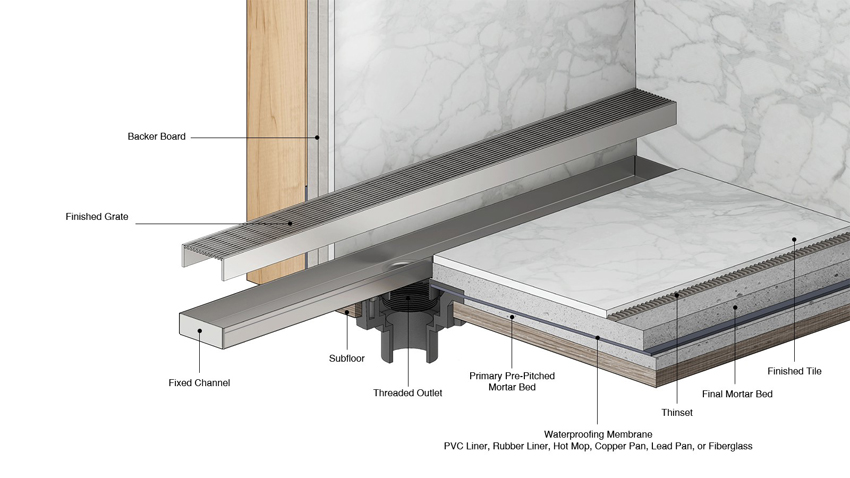
Shown is the construction assembly for a fixed-length linear drain system.
This is a set-size, set-outlet-location linear drain system, which means there is no on-site flexibility. This could be a limitation or hindrance in a custom home or high-end renovation. But for new construction or large multifamily or hospitality projects where speed of installation is a priority, fixed-length systems can be a good option. Depending on the manufacturer, the outlet is either centrally placed or offset.
Fixed-length linear drains have pre-pitched channels because the outlet location is predetermined. The illustration shows a fixed-length drain side detail. Notice the use of the clamping floor drain and sandwich-style installation. The channel comes in one welded piece instead of components like the site-sizeable model. Channels are constructed of either PVC or stainless steel depending on the manufacturer, and most companies offer a custom fabrication service if needed.
Challenges with using a fixed-length drain system include achieving a perfect wall-to-wall installation and being able to adjust to normal construction tolerances. If the wall or outlet location is off by any amount, the specified drain may no longer fit the space.
These are drains that work with traditional waterproofing techniques. However, modern waterproofing techniques call for different types of linear drain system solutions.
It is no wonder that the specification of a shower drain could be overlooked, especially in a high-end bathroom. Here, the designer or architect naturally focuses most heavily on the selection of tile, stone, fixtures, cabinetry, lighting, the heated towel rack, the flow of the space, and so much more. The choice of drains may well be left to the plumber. And while the plumbing contractor has deep knowledge of showers and drains, by the time this trade shows up on the job site or studies the plans, many waterproofing details that are already in place may limit the options to a standard, commonplace drain in the middle of the enclosure.
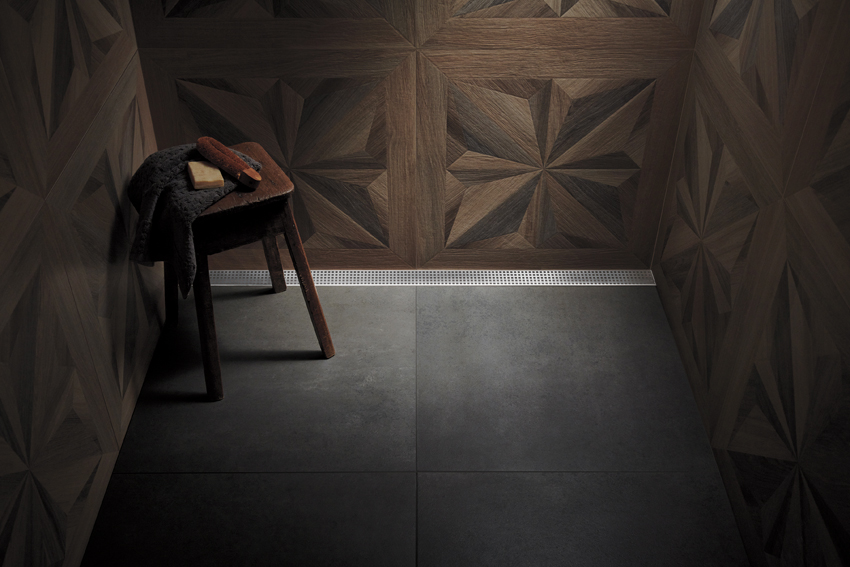
All images courtesy of Infinity Drain
Linear drain systems allow for the use of large-format tile and large stone slabs that do not need to be cut to create a central drainage plane.
However, there is another option: the specification of a sleek, stylish linear drain system that kicks the shower up to another level of sophistication.
Linear Drains and Their Benefits
For the clients of Miami-based interior designer Amber Engebretson, LEED AP, ID+C, product selection comes down to aesthetics and a high-end look.
“Clients are looking for something different and want something that sets their property or project apart from others,” Engebretson explains. “A linear drain is one of the details that does this.”
Linear drain systems can be found in many high-end projects. For example, 512 linear drain systems were customized for the TWA Hotel at the John F. Kennedy International Airport. Linear drain systems were included in the bathrooms and spas at the renowned One57 building located in the center of the city. Linear drain systems can also be found at the Century Plaza Hotel in Los Angeles, the Hard Rock Hotel in Orlando, Florida, and the Quicken Loans Arena in Cleveland, Ohio.
Linear drain systems have more than good looks going for them as compared to traditional center-placed drains. As Engebretson notes, linear drain systems can eliminate the need for the difficult, time-consuming, and expensive cutting of high-end stones to create a complicated slope. They are also an essential feature in a high-end wet room that can be sprayed down and sanitized. Linear drain systems perform well in Americans with Disabilities Act (ADA) approved showers. And they add form and function to their original use, which is in landscaping and outdoor settings.
Linear Drain Systems versus Traditional Drain Systems
To understand the basic differences between linear drain systems and traditional drain systems, consider a traditional shower enclosure. This is one where the drain is in the middle of the shower, with the shower floor sloping 360 degrees in a bowl shape toward the center. While this four-way pitch is standard in many budget or unexceptional showers, such a placement can limit flooring material choices. The typical scenario is to either specify a small mosaic tile or create the need to cut large-format tile on a diagonal to accommodate the floor pitch. In this way, the stone is pie-pieced together to accommodate the floor pitch.
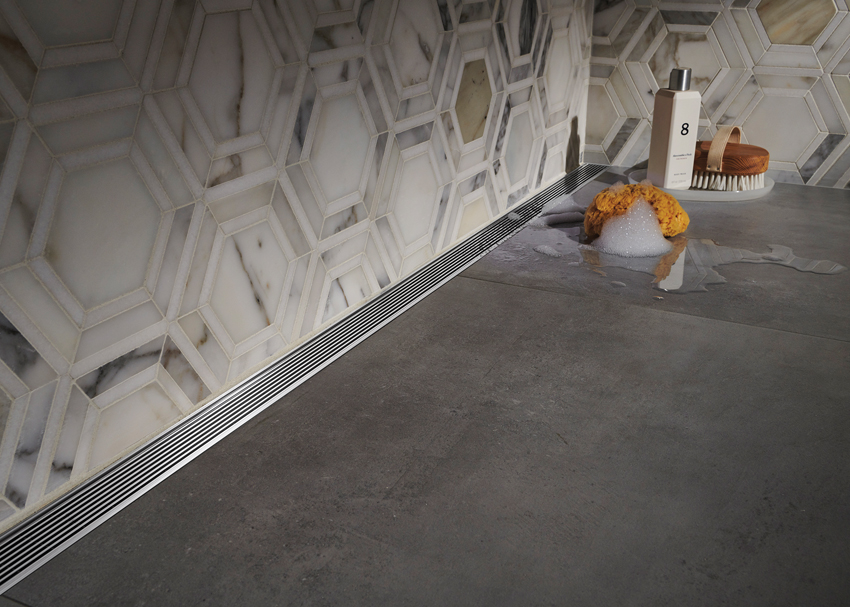
A linear drain system negates the need to create a 360-degree slope for a center drain.
With a linear drain system, the location of the drain is changed from the center of the shower to placement along one of the side or back walls or along the threshold of the shower enclosure. In this scenario, the floor is sloped toward the linear drain in one plane, as opposed to the four-way pitch toward the middle. This allows the use of large-format tile, stone slab, or any solid-surface material. And, because the floor is sloping in one direction toward the linear drain, the integrity of the tile or stone is maintained and not cut up to accommodate the dish-style pitch.
When specified early in the planning phase, the drain can become a sleek aesthetic feature rather than a lost design opportunity that is specified by the installer.
There are two ways to specify a linear drain system. One is based on form, or style, while the other is based on function, or intended use and infrastructure. One is based on visual preference; the other is based on performance. We will discuss form here and function a bit later.
Specifying A Linear Drain System Based on Form
Depending on the linear drain system manufacturer, there are typically four types of decorative top grate styles: wedge wire, perforated, tile insert, and solid, discussed as follows.
Wedge wire grate: Wedge wire grates are the sturdiest of all the grates, typically constructed of grade 316 stainless steel. This type of stainless steel is food grade and salt and chemical resistant. It contains 16 percent chromium, 10 percent nickel, and 2 percent molybdenum. The latter helps resist corrosion. Such grates may have a load rating of up to 5,000 pounds. This is an appropriate option for bathrooms and outdoor installations.
Perforated grate: Perforated grates are typically the least expensive and may be constructed of grade 304 stainless steel. This type of stainless steel contains 18 percent chromium and 8 percent nickel. Manufacturers offer different patterns, but these grates are essentially fabricated the same way on a break press with the pattern either punched or cut on a laser.
Tile insert frame grate: The tile insert frame allows the drain to blend in with the rest of the shower floor, essentially making it disappear. The tile insert tray comes empty, and the tile setter makes a mini tile floor within the tray. Depending on the manufacturer, the frame can accommodate flooring material up to ¾ inch thick. In this style, there is a ¼-inch gap between the tile frame and the linear drain channel. This is where the water drains down to the outlet and through to the waste line.
Solid grate: The solid grate is a bit of a hybrid between the perforated grate and the tile insert frame grate. There are no perforations in the stainless steel top, so the water drains around the edges in the ¼-inch gap on all four sides into the channel. This style of top can also be fabricated in glass.
All linear drain top grates can be removed via a hook, key, or household tool to clean or service the drain. Most also come with supplemental hair catchers.
Specifying A Linear Drain System Based on Function
Which linear drain system is best for a given project? This is based on whether it is a barrier-free bathroom and which waterproofing technique the installer will be using.
Traditional versus Modern Waterproofing
The difference between traditional and modern waterproofing methods is being able to tile directly on the waterproofing membrane (instead of having a secondary mortar layer), which saves floor height in installation and can be beneficial in designing barrier-free and curbless showers.

The difference between traditional and modern waterproofing methods is being able to tile directly on the waterproofing membrane (instead of having a secondary mortar layer), which saves floor height in installation and can be beneficial in designing barrier-free and curbless showers.
Traditional North American waterproofing methods require multiple levels of installation, skill sets, and limited square footage. The traditional method for installing a tiled shower begins with the installation of a mortar bed that is sloped to the weep holes in the clamping floor drain. A waterproofing membrane, typically referred to as a pan liner, is subsequently placed over this "pre-slope" and clamped into the drain.
Regionally Specific Waterproofing Methods
Pan liners may consist of metals such as lead and copper, or plastics such as polyvinyl chloride (PVC)and chlorinated polyethylene (CPE). In the Northeastern part of the United States, lead or copper pans are still a popular way to waterproof a shower.
In some regions of the country, specifically in Southern California, installers also employ hot mop systems that involve applying layers of asphalt and roofing felt to build up a pan liner. Pan liners are carried up to a height of at least 3 inches above the finished height of the curb and must not be penetrated by any fasteners. Pan liners are not designed to allow for the direct application of ceramic or stone tile.
Membrane and Pan Liner
The most mainstream way to waterproof a shower, and what most showers in the United States utilize, is the vinyl pan liner or rubber liner. This method uses a thick yet flexible membrane to create an envelope on the shower floor and up a small portion of the walls. It is almost like wrapping a present or doing origami.
There are two types of linear drain systems that are a good fit for showers with traditional waterproofing methods: site-sizable linear drains and fixed-length linear drains.
Site-Sizable Linear Drain Systems
Site-sizeable linear drains work with the standard installation using a shower pan liner and a clamping floor drain to connect to the waste line.

Site-sizable linear drains allow for more flexibility during installation.
This system is sold as a complete kit, and modifications can be made to the length and outlet placement on-site. This provides ultimate flexibility in making the drain work for the site-specific conditions. It also allows the drain to be sized on-site for a perfect wall-to-wall installation. In theory, a linear drain does not technically need to go from one wall to the opposite wall. However, wall-to-wall installations look more pleasing to the eye. And functionally, it allows a true one-plane floor pitch with no water pooling in the corners of the shower. This also creates complete water removal when placed along the threshold of the shower with no curb or barrier.
In this system, channels are constructed of stainless steel or PVC and utilize a neutral pitch (meaning a flat-bottom channel). Because the outlet is located on-site, the channel cannot come pre-pitched. It is a common misunderstanding that the channel for a linear drain system requires a drastic pitch to get the water headed toward the outlet. Water is always looking for its low point or level—that is the outlet. Through capillary action, as the channel fills with water, it pulls itself down the waste line. What is left in the channel are water droplets held on via surface tension.
Consider a site-sizeable linear drain installation with a PVC channel. This ‘sandwich’ style of installation is characterized by the waterproofing being ‘sandwiched’ by the two mortar layers. Thus, a secondary mortar bed must be installed to provide load distribution and a bonding surface for the floor tile. Pea gravel is placed around the clamping floor drain’s weep holes to prevent blockage before installing the secondary mortar bed. This installation can be summed up as a ‘sandwich’ style of install: Mortar, waterproofing membrane, mortar. The mortar is the bread of the sandwich, and the waterproofing membrane is the meat.
Site-sizeable linear drains may be available with either a PVC or stainless steel channel. Some local municipalities such as New York, Chicago, and San Francisco require all-metal plumbing components. In these cases, the all stainless steel site-sizable linear drain is the appropriate option.
Fixed-Length Linear Drain Systems
The second type of linear drain that works with traditional waterproofing and a clamping floor drain is a fixed-length linear drain system.

Shown is the construction assembly for a fixed-length linear drain system.
This is a set-size, set-outlet-location linear drain system, which means there is no on-site flexibility. This could be a limitation or hindrance in a custom home or high-end renovation. But for new construction or large multifamily or hospitality projects where speed of installation is a priority, fixed-length systems can be a good option. Depending on the manufacturer, the outlet is either centrally placed or offset.
Fixed-length linear drains have pre-pitched channels because the outlet location is predetermined. The illustration shows a fixed-length drain side detail. Notice the use of the clamping floor drain and sandwich-style installation. The channel comes in one welded piece instead of components like the site-sizeable model. Channels are constructed of either PVC or stainless steel depending on the manufacturer, and most companies offer a custom fabrication service if needed.
Challenges with using a fixed-length drain system include achieving a perfect wall-to-wall installation and being able to adjust to normal construction tolerances. If the wall or outlet location is off by any amount, the specified drain may no longer fit the space.
These are drains that work with traditional waterproofing techniques. However, modern waterproofing techniques call for different types of linear drain system solutions.
Modern Waterproofing Techniques
Modern waterproofing techniques are normally performed by the tile trade and fall into two types: liquid membrane and fabric sheet/membrane.
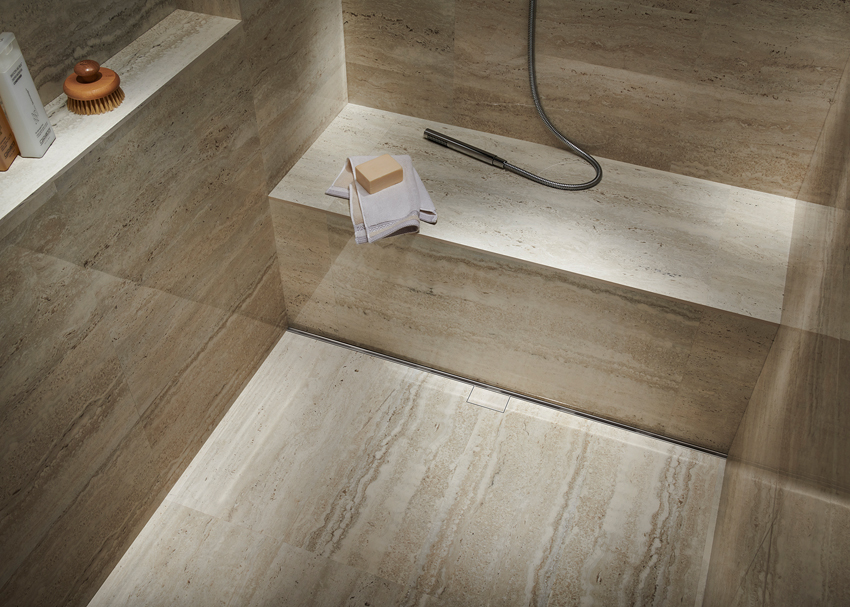
Liquid membrane waterproofing techniques can be used to create benches in the shower.
Liquid membrane is a paint-on material that has the consistency of yogurt. It dries into a hardened, rubberized membrane that can fit any shape shower enclosure and can be used on benches, niches, and into the “dry” area of the bathroom (outside the area dedicated to the shower) to easily create a wet room (where the whole room is waterproofed).
Fabric membrane waterproofing uses a non-woven fleece fabric. It is applied to the sloped mortar bed using thinset. Cove and corner pieces are used to waterproof the entire shower enclosure. This can also be used as a vapor barrier if the shower contains a steam unit.
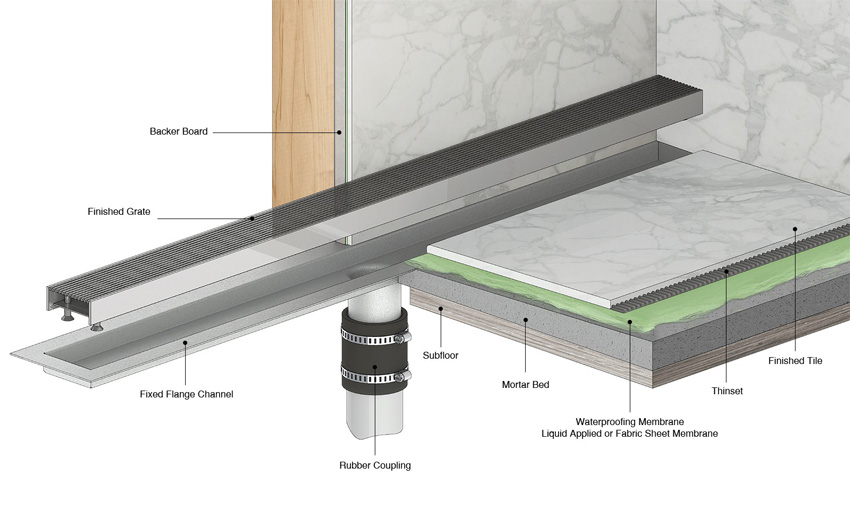
Shown is a fixed-flange installation.
A fixed-flange installation uses a liquid membrane waterproofing. Instead of the sandwich of traditional waterproofing, this could be thought of as an open-face sandwich. It includes one mortar layer, waterproofing, thinset, and then tile.
Note that the channel shape is different than site-sizable or fixed-length drain and has a 1-inch flange on all four sides. Instead of tiling to the side of the channel as would be done with traditional waterproofing, tile is applied directly on top over the channel flange. Waterproofing is either painted on to the flange edge or fabric is glued to the edge to make the shower watertight. Thus, there is no waterproofing membrane to clamp onto, so a coupling is used to connect the channel outlet to the waste line.
Complete Shower Systems
Finally, under the umbrella of modern waterproofing is the newest innovation in shower construction: a complete shower system. This takes guesswork out of shower construction and saves time and labor at the job site.
A complete shower system includes a linear drain, a pre-sloped shower floor, and wall board. There may also be accessories such as benches and niches available as part of the system. The wall board and pre-sloped shower floor may be pre-faced with fabric or liquid waterproofing, or the waterproofing may need to be applied on-site depending on the manufacturer.
These types of complete showers usually come with a system warranty, which gives homeowners, installers, and specifiers a level of protection.
Considering Flow Rate
Flow rates of the specified shower fixtures need to be calculated early in the planning phase. The linear drain must be able to handle the combined flow rate of the fixtures installed in the shower. For example, a shower may include a rain head, hand-held, and traditional shower head, each with a flow rate of 2.5 gallons per minute. Standard linear drains can generally handle up to 9 gallons of water per minute and connect to a 2-inch waste line. High-flow versions that connect to a 3-inch waste line will accommodate a flow rate of 21 gallons of water per minute.
Latest Advances: Stainless Steel Shower Bases
One of the latest advances at the forefront of architectural and decorative drains is specification of a stainless steel shower base. This is seen by some as a game-changing option for shower installation. Look for a manufacturer that guarantees for life against waterproofing failure so that if the product should develop a leak, the manufacturer will bear the cost of labor, removal, and replacement, and will restore the installation with the same ‘like and kind’ materials originally used.
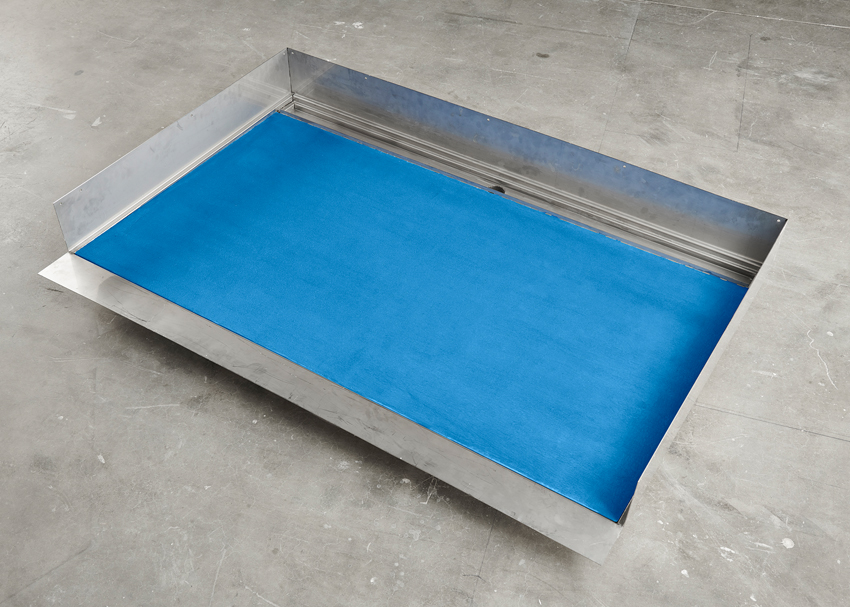
A stainless steel shower base is a game changer for some in the plumbing business.
Stainless steel shower bases are an example of “innovative, customizable solutions that makes shower installation a far more seamless experience,” says Infinity Drain President Jonathan Brill. “As waterproofing methods continue to evolve from traditional to more time-saving approaches that eliminate steps in the process, we are reflecting that change in the products we develop.”
Stainless steel shower bases also dramatically reduce the amount of time required to install a new bathroom shower and decrease the need for coordination between several trades. Because it is ready to tile, pre-sloped, and does not require additional waterproofing on the walls, it eliminates many time-consuming steps that traditional methods require.
Depending on the manufacturer, stainless steel shower bases include a curb or curbless option and the ability to use any grate style or tile insert.
Where to Place the Linear Drain System
The most popular linear drain placement is along the back wall. If the shower has a curb, you can essentially place the drain along any side since there is a physical barrier between the dry and wet side of the bathroom.
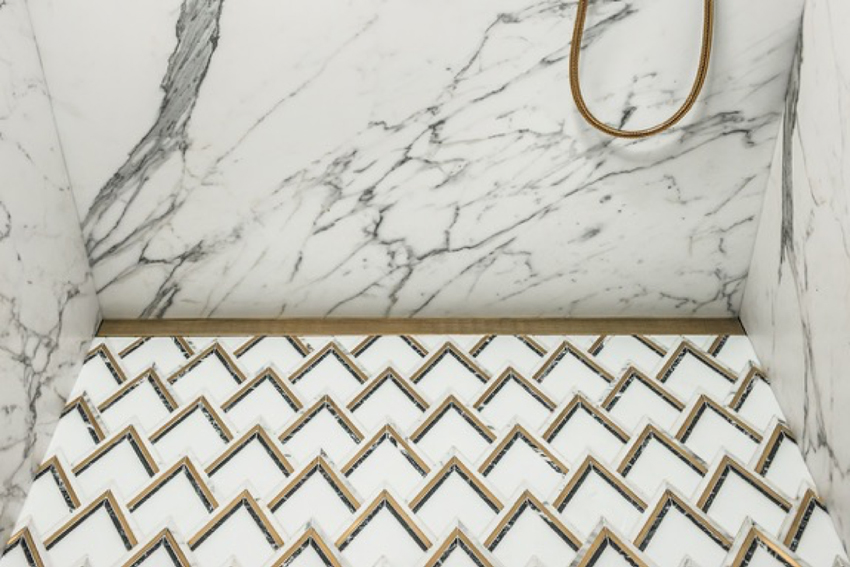
The most popular placement for a linear drain is along the back wall of the shower enclosure.
When removing a tub to create a large shower enclosure, site-specific conditions may require that the linear drain is placed along the wall with the shower fixtures. This is most likely where the tub drain was located. Depending on which way floor joists are running, the waste line may be able to be relocated closer to the finished wall.
Placing the drain along the threshold of the shower is popular for barrier-free or curbless showers. For this installation, a wall-to-wall fit is critical to keep water from traveling to the dry side of the bathroom. With this placement, it is always recommended that the dry side of the bathroom be waterproofed and pitched slightly toward the linear drain.
For a true wet room, which will be discussed in more detail later in the course, the entire bathroom is waterproofed and sloped toward the drain.
Linear Drains and Wet Room Showers for Maximum Sanitation
With a global heightened aware of germs, viruses, and the need for sanitation, wet room showers may well become more common. A wet room shower is unlike a typical bathroom in that there is not a distinction between the wet part of the bathroom where the drain is located (the shower area in most bathrooms) and the dry part of the bathroom where there is no drain. In a wet bathroom, the entire floor slopes toward one drain. A linear drain is ideal for such an application.
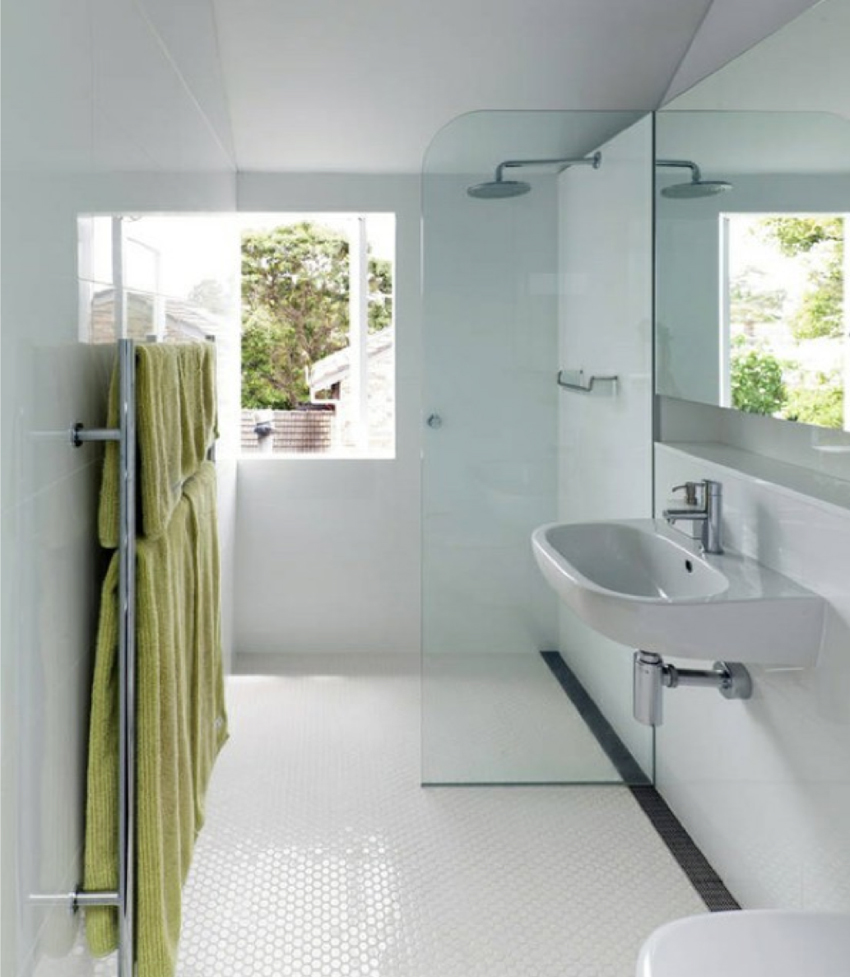
With a linear drain along one wall, the entire bathroom can be washed down and sanitized.
In this case, the drain transitions from being a shower drain to becoming a floor drain. Having a floor drain is like an insurance policy in case there is a plumbing failure on the dry side of the bathroom. The bathroom can also be sprayed down and squeegeed for cleaning.
Wet rooms can be created in any size, from small guest baths to luxury master bathrooms. A smaller space may lend itself to including a shower enclosure with no glass partition. Or, a shower or tub could be enclosed behind the glass. For a larger bathroom, the shower and tub could be located in separate areas of the bathroom, completely barrier free. This means the space is spread out enough so that the sink or toilet will not get overspray from the showerhead.
In a wet room, all floors and walls are waterproofed and tiled so that they can efficiently shed moisture. Floors are sloped, and all water exits the wet room through a high-performing linear drain or center drain.
A barrier-free wet bathroom is likely to increase the attractiveness of a home or hotel room because of the sanitation potential and accessibility, and waterproofing benefits can help protect the area from potential water damage.
The Benefits of Curbless Showers
Stepping over the curb to get into a shower is something most clients are accustomed to, but specifying a curbless shower is also an option.
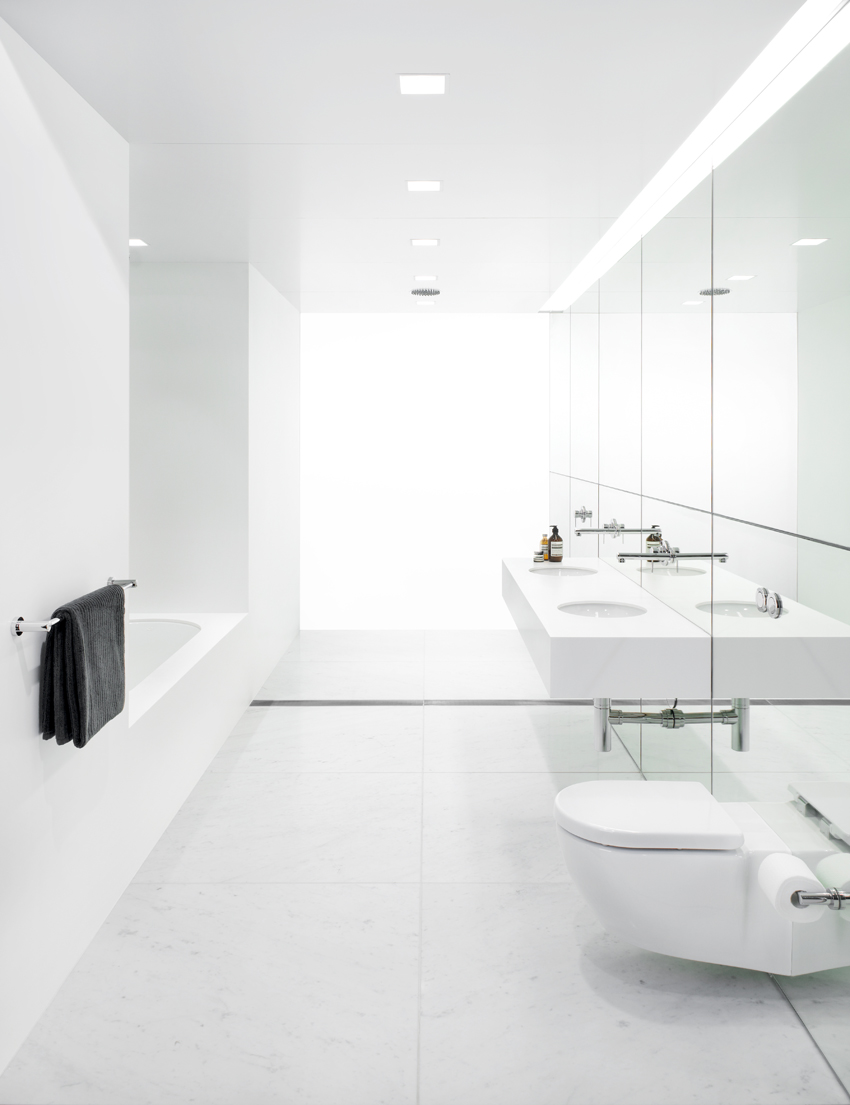
Linear drain systems help create a curbless shower enclosure.
A barrier-free or curbless shower creates a sensation of seamless flow and presents a spa-like appearance that is elevated above a traditional shower design. It is the equivalent of creating a “great room” in the bathroom. Without the curb, the bathroom floor flows from wall-to-wall and makes a bathroom appear larger. This is especially true for small- to medium-sized bathrooms that are visually chopped up by a shower curb.
A curbless shower is a great equalizer, accommodating the needs of everyone in a home or hotel room. It offers people of all ages and abilities the freedom to safely enter the shower without the need to climb over a threshold or into a tub.
A barrier-free or curbless shower means cleaning is easier. A seamless design without surface joints means there are fewer areas where mildew and other grime that is difficult and unpleasant to clean can gather.
A barrier-free shower actually keeps the water where it is supposed to be, which is counter intuitive when there are no walls or barriers of any kind to catch the water. But barrier-free showers are built so that the shower floor is sloped toward the linear drain, keeping the water out of the bathroom and making for the most efficient evacuation of water. Of course, it is also important to position the shower head properly to keep water in the splash zone.
With a curbless shower and a linear drain against one wall, there are fewer limitations on tile size or slab materials that the designer can specify.
Linear Drain Systems and Ada Requirements
Creating a barrier-free shower is essentially what happens in most bathrooms that are compliant with the ADA. Linear drain systems are ideal in such applications.

Barrier-free bathrooms can be sleek and elegant.
Note that the following measurements represent absolute minimums. Larger spaces increase maneuverability and ease of washing. Clients do not have to be currently confined to a wheelchair to make use of ADA-compliant shower enclosures. Homeowners designing their forever home, those who plan on aging in place, and those who embrace universal design principles can all make use of these shower guidelines. It may also be useful to put a barrier-free shower on the first floor of a multi-floor residence in case the homeowner or a guest is not physically able to ascend the stairs or step into a tub-shower.
Types of ADA-Compliant Shower Enclosures
There are three types of ADA-compliant shower enclosures. Two types allow the bather to fully roll into the shower enclosure, while the smallest enclosure requires bathers to transfer themselves to a seat in the space.
Transfer-Type Shower Compartments
The first type of compliant shower enclosure is the transfer-type shower. In this model, the bather does not need an aide and can physically transfer herself or himself from a wheelchair into the shower enclosure to sit on a seat. This is the smallest allowed shower enclosure and the only configuration that allows a curb.
Guidelines call for a minimum clearance of 36 inches wide by 36 inches deep, measured from the control wall.
Because there is a curb in the shower, a linear drain may be placed along any side. If there is no curb in the shower, the recommended drain placement for a shower of this size would be along the threshold of the enclosure going wall-to-wall.
Standard Roll-in Type Shower Compartment
A standard roll-in type shower is one where there may be an aide present helping the bather, and he or she is able to fully roll into the shower area in a wheelchair. According to guidelines, a curb along the threshold is only allowed if it is no taller than ½ inch and beveled to make rolling over easier.
The ADA guidelines indicate that a minimum clearance of 60 inches wide and 30 inches deep should be provided adjacent to the open face of the shower compartment. The recommended placement for a linear drain system would be along the threshold of the shower to create a wet room.
Alternate Roll-in Type Shower Compartment
An alternate roll-in type shower, as defined by the ADA, is also one where there may be an aide present helping the bather, and he or she is able to fully roll into the shower area. In this setup, the entrance is narrower and not as open and the standard roll-in type. As with the standard roll-in shower, a curb along the threshold is only allowed if it is no taller than ½ inch and beveled to make rolling over easier.
In this type of compartment, a minimum clearance of 60 inches wide and 36 inches deep should be provided adjacent to the open face of the shower compartment. The 36-inch-wide entrance is an important dimension to consider when designing a space with accessibility or universal design in mind.
The linear drain should span from wall-to-wall inside the shower enclosure. This will keep water from pooling under the shower seat and allow a consistent one-plane floor pitch.
Outdoor Architectural Trench Drain Design and Applications
While outdoor drainage is the final topic discussed in this course, linear drains were actually introduced in architecture as outdoor drainage features, and then over time they were expanded for use in bathrooms. The main difference in the specification of outdoor and indoor linear drain systems is that the outdoor setting is less controlled by the designer and more likely affected by natural elements.
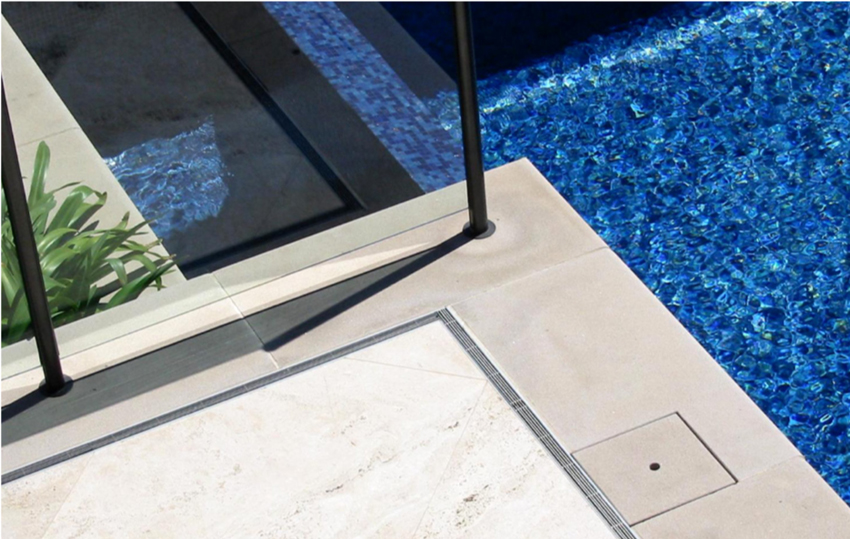
The original use of linear drains was in outdoor applications.
Landscape and hardscape drainage plans are typically calculated by an engineer using geographic and rainfall information for a given area and how many square feet of surface the drain will be accommodating. Popular locations for evacuating water in a landscape include along door tracks, between pavers, and in the garden with the use of French drains.
Balconies, terraces, and patios also benefit from linear drains to move water away from the structure and to capture runoff. These areas may or may not be waterproofed depending on what is below the raised area.
Pool decks are an obvious choice for a linear drain system and what probably comes to mind when linear drains are considered. Linear drains can aid in pool safety by capturing splashes from the pool or water generated from the deck being hosed down. They can also evacuate rainwater from the pool area. In all cases, linear drains help a surface to dry more quickly.
Incorporating a linear drain into the design of a wet deck or wet-edge pool creates a pond effect without the elevation needed for a true infinity-edge pool. In this case, the linear drain manufacturer would work directly with the pool contractor to fabricate the channel and grate to their specifications.
Specialty applications for outdoor linear drains include creating the look of an infinity pool in the pool surround as well as in outdoor showers.
Conclusion
While at one time the drainage system specified for showers may have been of little consequence, this has since changed with the growing popularity of linear drain systems. The stainless steel materials used for these systems holds up to corrosion and makes cleaning easier. Linear drain systems are typically associated with high-end architecture. However, they can be specified for more moderate projects, adding the high-end look for a reasonable cost. In all cases, the waterproofing method used will determine the type of linear drain system that can be used. It is incumbent on the architect, designer, or plumbing contractor to ensure that the waterproofing details and linear drain system are compatible.
Beyond high-end bathrooms, linear drain systems add form and function to wet rooms for maximum style and sanitation, as well as in ADA-compliant bathrooms and a wide variety of outdoor applications. With knowledge of linear drain systems, the savvy architect, designer, or plumbing contractor can add value to their projects.
Kathy Price-Robinson writes about building and design. Her remodeling series “Pardon Our Dust” ran 12 years in the Los Angeles Times. She specializes in buildings that are durable and resilient to climate disruptions, as well as products and designs that provide shade in hot climates. www.kathyprice.com




